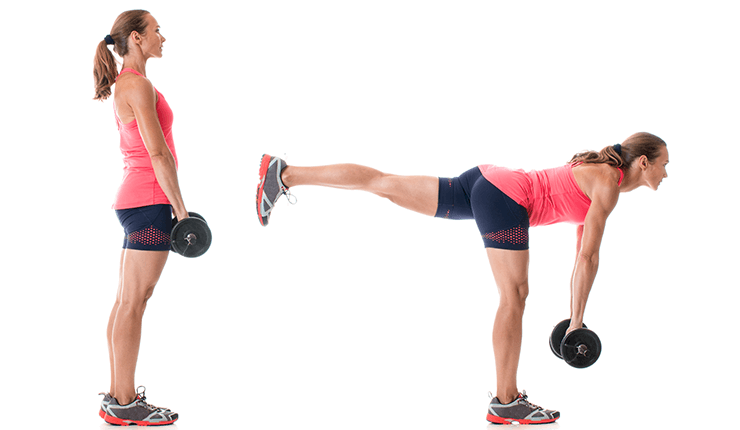Want to get attention and engagement on social media? Start an argument about a controversial topic in exercise science.
“Direct core work is dumb. Do squats and deadlifts and the core takes care of itself.”
“Traditional cardio is a waste of time. Just lift faster.”
“Your clients don’t need corrective exercises. Strength training itself is corrective.”
For every follower you lose, you’re likely to gain five more.
Only problem: Few things in exercise science are truly black and white. If it’s worth discussing, it’s worth going into more detail than you can fit on a bumper sticker.
That’s certainly true of the 10 controversial, polarizing, and hotly debated topics I tackle here:
- Flexibility vs. mobility
- Corrective exercise vs. “shut up and lift”
- Compound vs. isolation exercises
- Bilateral vs. unilateral lower-body training
- Moderate reps vs. higher and lower reps
- Full-body lifts vs. direct core work
- Core stability vs. core flexion and/or rotation
- Traditional cardio vs. metabolic resistance training
- Interval training vs. steady-state cardio
- Advanced monitoring techniques vs. the feel method
1. Flexibility vs. mobility
Our clients don’t need more passive flexibility, the movement gurus tell us. Too much of it might even increase injury risk . What we should focus on instead is mobility—active control over their range of motion.
Are the gurus right?
Kind of. Active range of motion is a physical quality worth pursuing. And too much passive flexibility can predispose that joint to injury.
But a lot of clients enjoy stretching. Combined with conscious breathing, they like how it feels at the end of a workout as they transition back into daily life. Some folks believe it speeds up recovery, too.
Verdict: Incorporate a client-specific mix of active mobility and passive flexibility training based on their personal preferences and the demands of their target activities.

You don't have to choose between mobility and flexibility work for your clients. Use whatever combination best fits their needs and preferences.
2. Corrective exercise vs. “shut up and lift”
Speaking of movement gurus:
They’ve convinced a generation of personal trainers to use cookie-cutter assessments to identify “movement dysfunctions” and prescribe “corrective exercises” to address them.
They meant well, but as so often happens in the fitness industry, they got ahead of themselves. Not only are there no universally agreed-on standards for movement, but we also now know the way people move doesn’t actually predict injury .
What some call “dysfunctional” may simply fall into the normal range of variability in movement.
On the flip side, some trainers don’t do any sort of assessment, and advocate putting clients under the bar right away—even if it’s their first time in the weight room. This can be problematic if the trainer doesn’t help the client find their optimal exercise setups, or has them use a load they’re not prepared to handle.
Verdict: Haphazardly subjecting a client to heavy lifting can put them at risk. Use exercise-specific assessments to find your client's best starting point for exercises like squats and deadlifts. Just don’t claim you’re identifying and correcting movement dysfunctions.
3. Compound vs. isolation exercise
Multijoint movements—squats, hinges, presses, rows, lunges—should form the foundation of your training programs. That’s not in any way controversial.
But compound movements aren’t the only choice for every muscle group.
Take the hamstrings and adductors, for instance. These are oft-injured muscles, especially in athletic populations.
While they do get worked in multijoint movements, research has shown that isolating them with Nordic hamstring curls and Copenhagen adductor raises can reduce injuries. As a bonus, clients can also get a nice pump where they aren’t used to having one.
Verdict: Prioritize compound lifts, of course. But there’s no reason to exclude single-joint exercises. Biceps curls and triceps extensions are classic examples of giving clients what they want, while the aforementioned movements for the hamstrings and adductors give some of them what they need.
4. Bilateral vs. unilateral lower-body training
Unilateral lower-body exercises offer similar strength and hypertrophy benefits as their bilateral counterparts , along with two distinct advantages:
- Lower compressive forces on the spine
- Higher stability requirement
And you’ll probably increase the overall training volume if you work one leg at a time, which could improve your client’s conditioning.
But traditional bilateral squats and deadlifts aren’t pointless, as some coaches have argued.
I can think of three reasons to use them:
- For clients who aspire to compete in powerlifting, they’re a must.
- For contact-sport athletes, training ought to prepare them for the high loads they’ll face on the field.
- Some clients just prefer them, either because they like the feeling of a heavy barbell in their hands or on their back, or because they want to measure their strength against well-known benchmarks.
Verdict: A mix of unilateral and bilateral lower body training works well for most clients. One simple, time-saving strategy is to include a bilateral knee-dominant exercise and a unilateral hip-dominant exercise in one session, then flip-flop for the next session.
For example, you might do a bilateral squat and single-leg Romanian deadlift in the first session, and in the next one do a bilateral deadlift combined with a rear-foot-elevated split squat.

Most clients will get the best results with a combination of bilateral and unilateral lower-body exercises.
5. Moderate reps vs. higher and lower reps
Classic training wisdom tells us that six to 12 reps is the optimal range for hypertrophy. Any lower and you’re primarily building strength. Any higher and you’re increasing endurance.
Those guidelines work well enough as shorthand, but they don’t tell the whole story. The latest research shows that any rep range can produce hypertrophy, as long as the volume is high enough and the sets are taken close enough to failure .
That said, the moderate rep range remains a convenient sweet spot for most clients.
Lower-rep training requires more recovery between sets, which either lengthens your training sessions or reduces the amount of work you can do in the allotted time. Meanwhile, high-rep sets taken to failure aren’t anyone’s idea of a fun way to train, and clients may object to the discomfort they induce.
Verdict: If a client’s primary goal is hypertrophy, six to 12 reps will always be the most convenient range. But if a client wants to maximize their muscular potential, some evidence suggests you should use a variety of rep ranges .
6. Full-body lifts vs. direct core work
Coaches who believe direct core work is unnecessary have a point: Full-body barbell lifts do, in fact, elicit high levels of activation in the trunk muscles .
But that doesn’t mean you shouldn’t ever train the core directly.
For untrained clients, or those returning from an injury or illness, the midsection is often a weak link. They’ll do well with a few sets of direct core work toward the end of the session. On the opposite end of the spectrum, for clients with exceptionally strong core muscles, direct work is the best way to provide a significant training stimulus.
And lots of people in between those extremes simply enjoy feeling the burn in their abs, as with other “mirror muscles.”
Verdict: To supplement full-body lifts, select a handful of exercises that work the core directly and address the client’s needs and goals.

Even your strongest clients can benefit from direct core training.
7. Core stability vs. core flexion and/or rotation
On one side, you’ll find biomechanics experts (along with internet “experts”) who argue that the purpose of the core is to prevent motion, not create it . They advocate for anti-movement core exercises like dead bugs, bird dogs, and side planks.
Yet anecdotally, we hear about elite athletes who regularly do hundreds or even thousands of crunches and not only perform well but remain free of back pain.
The truth is, high-volume lumbar flexion and rotation exercises may be a bad idea for a client who’s deconditioned or has a history of back pain. But that’s hardly unique to core training. Any exercise can be counterproductive if we prescribe too much, too soon.
For clients who enjoy them and are prepared for them, it’s perfectly safe to include a few sets of sit-ups, crunches, or Russian twists in their program. Heck, they may even provide some functional benefits along with their aesthetic value .
Verdict: Train the core statically and dynamically for clients who can tolerate it. Just be smart about it. Build volume slowly and cautiously, as you would with any other part of your training program.
8. Traditional cardio vs. metabolic resistance training
Metabolic resistance training, in theory, allows you to increase cardiovascular fitness while also building muscle. Which, understandably, makes some coaches wonder why they would ever want their clients to do traditional cardio.
If you’ve read the previous items, you can guess the number-one reason: Some clients simply enjoy walking, running, swimming, or cycling in between personal training sessions, and there’s no reason to talk them out of it.
You also need to be cautious about pushing clients into metabolic resistance training before they’re ready for it. That’s especially true of CrossFit-type workouts, where you do heavy, technical lifts for time in a fatigued state. For clients who aren’t well prepared, the risk far outweighs any potential reward .
Verdict: Metabolic resistance training, with appropriate exercise selection, can be both fun and beneficial for clients who’re ready for it.
But don’t forget that traditional cardio also offers health and conditioning benefits. If a client wants to do it, in or out of the gym, include it in their program.

Metabolic resistance training can produce fast improvements in body composition and aerobic fitness. But traditional cardio is still beneficial for health and recovery from more intense workouts.
9. Interval training vs. steady-state cardio
This argument is similar to the previous one, and even predates it by a decade or two. The only difference is that we’re talking about two different ways to do more or less the same thing—increase endurance and burn fat—without resistance training thrown into the mix.
Proponents of high-intensity interval training (HIIT) are quick to boast about the superior calorie-burning efficiency of their methods, compared to steady-state cardio .
They’re right, if we’re comparing genuine HIIT to someone pedaling at a snail’s pace on a stationary bike while watching Netflix, which probably isn’t providing much of a training effect. At most, it potentially promotes recovery from intense training .
But there’s an easy fix: Encourage the client to bump up the intensity slightly.
By holding their heart rate in the neighborhood of 110 to 130 beats per minute for 20 to 30 minutes, they’ll see steady increases in cardiovascular fitness. And unlike HIIT, which offers quick increases in VO2 max, the client won’t quickly reach a plateau .
Verdict: Interval training and steady-state cardio both burn calories and increase cardiovascular fitness. Ideally, clients will do some of both, but if they prefer one over the other, encourage them to increase the intensity and/or duration in a progressive way.
And from time to time, remind them that the fat-burning effect of any type of training is highly overrated.
10. Advanced monitoring techniques vs. the feel method
Activity-tracker technology allows us to monitor every step, heartbeat, minute of sleep, and calorie consumed or expended.
But just because our clients can track fancy readiness metrics like heart-rate variability, does that mean they should? Or should we ditch the expensive gadgets and just base training decisions on how clients feel?
For elite athletes, high-tech monitoring strategies can provide a competitive edge. But for the average gymgoer, these devices may paradoxically provide too much data.
Verdict: A simple device that counts steps and measures heart rate is a happy medium for most of the general population.
Final thoughts
Never forego an entire training methodology simply because one expert, in an effort to get attention, insists on its uselessness. Avoid such polarizing stances on fitness topics. When you keep an open mind, you’ll find that the middle of the road is the most defensible position on most issues.
By exposing your clients to a full range of training stimuli, you improve their health and fitness in multiple ways—and give them more reasons to look forward to your training sessions.
References
J. L. Nuzzo, “The case for retiring flexibility as a major component of physical fitness,” Sports Medicine, vol. 50, no. 5, pp. 853–870, 2020.
R. Bahr, “Why screening tests to predict injury do not work, and probably never will: A critical review,” British Journal of Sports Medicine, vol. 50, pp. 776–780, 2016.
N. Van Dyk, F. P. Behan, and R. Whiteley, “Including the Nordic hamstring exercise in injury prevention programs halves the rate of hamstring injuries: A systematic review and meta-analysis of 8,459 athletes,” British Journal of Sports Medicine, vol. 53, no. 21, pp. 1362–1370, 2019.
J. Harøy et al., “The Adductor Strengthening Program prevents groin problems among male football players: A cluster-randomized controlled trial,” British Journal of Sports Medicine, vol. 53, no. 3, pp. 145–152, 2019.
M. Jones, J. Ambegaonkar, B. C. Nindl, J. A. Smith, and S. A. Headley, “Effects of unilateral and bilateral lower-body heavy resistance exercise on muscle activity and testosterone responses,” Journal of Strength and Conditioning Research, vol. 26, no. 4, pp. 1094–1100, 2012.
B. J. Schoenfeld, J. Grgic, D. Ogborn, and J. W. Krieger, “Strength and hypertrophy adaptations between low- vs. high-load resistance training: a systematic review and meta-analysis,” Journal of Strength and Conditioning Research, vol. 31, no. 12. pp. 3508–3523, 2017.
B. Schoenfeld and J. Grgic, “Evidence-based guidelines for resistance training volume to maximize muscle hypertrophy,” Strength and Conditioning Journal, vol. 40, no. 4, pp. 107–112, 2018.
N. Hamlyn, D. Behm, and W. Young, “Trunk muscle activation during dynamic weight-training exercises and isometric instability activities,” Journal of Strength and Conditioning Research, vol. 21, no. 4, pp. 1108–1112, 2007.
S. McGill, “Core training: Evidence translating to better performance and injury prevention,” Strength and Conditioning Journal, vol. 32, no. 3, pp. 33–46, 2010.
B. Contreras, B. Schoenfeld, N. Zealand, and G. F. Services, “To crunch or not to crunch: an evidence-based examination of spinal flexion exercises, their potential risks, and their applicability to program design,” Strength and Conditioning Journal, vol. 33, no. 4, pp. 8–18, 2011.
P. T. Hak, E. Hodzovic, and B. Hickey, “The nature and prevalence of injury during CrossFit training,” Journal of Strength and Conditioning Research, Nov. 2013.
M. Gibala and S. McGee, “Metabolic adaptations to short-term high-intensity interval training: a little pain for a lot of gain?,” Exercise and Sport Sciences Reviews, vol. 36, no. 2, pp. 58–63, 2008.
R. Ortiz, A. Sinclair Elder, C. Elder, and J. Dawes, “A systematic review on the effectiveness of active recovery interventions on athletic performance of professional-, collegiate-, and competitive-level adult athletes,” Journal of Strength and Conditioning Research, vol. 33, no. 8, pp. 2275–2287, 2019.
S. Seiler and E. Tønnessen, “Intervals, thresholds, and long slow distance: the role of intensity and duration in endurance training,” Sportscience, vol. 13, pp. 32–53, 2009.










